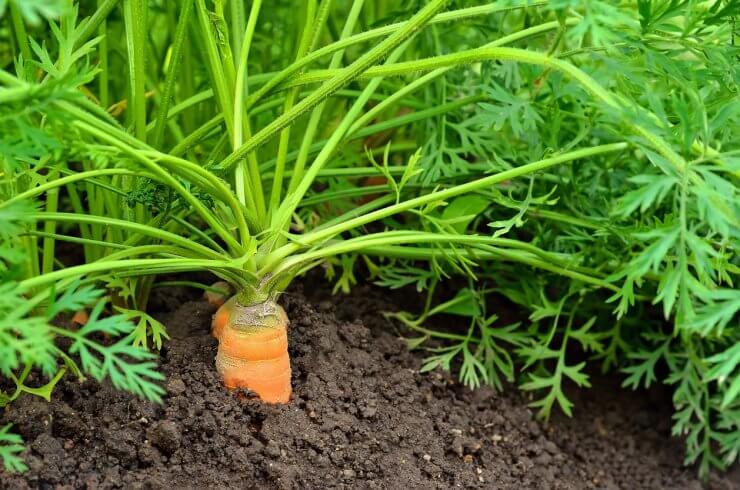
Carrots growing in the garden
Carrots fall into two main groups: early and maincrop. As their name suggests, early carrots mature earlier than their maincrop counterparts. In general, early carrots are ready for harvest in about 60 days; maincrop carrots mature in 70 to 85 days.
All carrots are variations of Daucus carota, whose close cousin is Queen Anne’s lace—that lacy wildflower you often see growing on the roadside. Some people consider it a weed; others classify it as a wildflower. While it’s in the carrot family, its roots are not tasty.
Carrots are actually a biennial plant, but we grow them as an annual because we want to eat the sweet roots. If you leave carrots in the ground (in milder growing regions), they’ll produce flowers and seeds the following year. But don’t try harvesting the roots to eat; all their energy will have gone to the production of flowers and seeds, and you’ll be left with a less than tasty root. You will, however, have some beautiful flowers—and seeds to start with the following season. But if you’re growing carrots for food, harvest them the season you plant them.
There are five broad categories of carrots, many of which you’ll never see at your local grocery store. There’s a whole world of interesting carrots you can grow at home, and they’ll always taste far better than anything you can buy at a chain grocery store.
Here’s an overview of the five types of carrots:
Nantes carrots
These are the carrots you usually see at the grocery store: long, orange, cylindrical roots with blunt ends. Nantes carrots are a hardy bunch; they can grow well even in soil that’s a little dense. They’re a very popular choice for home gardening. And if you grow them at home, you have a much broader choice of varieties, including:
- Bolero (orange)
- Napoli (orange)
- Scarlet Nantes (not orange)
- White Satin (also not orange)
Imperator carrots
Imperator carrots are the kings of the carrot world: they tend to grow larger than many other types of carrots, and they have a high sugar content, which gives them good shelf appeal. Some Imperator carrots are:
- Atomic Red
- Autumn King
- Cosmic Red
- Tendersweet
Chantenay carrots
Chantenay carrots can grow well in soil that’s less than ideal. They tend to be on the short and stout side. If you like your carrots sweet, harvest your crop early. Some Chantenay varieties include:
- Hercules
- Red Cored Chantenay
- Royal Chantenay
- Short Stuff
Danvers carrots
Danvers carrots have almost no core and tends to do well even in heavy soil. They’re often called “half-size” because they don’t grow as large as other types. They’re best harvested young; the older the roots get, the more fibrous they become. Danvers type carrots include:
- Danvers 126
- Danvers Half Long
Miniature carrots
OK, so you can call almost any carrot “miniature” if you harvest it early. But some carrots only grow to small sizes, making them ideal for container gardening. Some grow into slender finger-size carrots; others grow into little globes of orange goodness. Miniature types include:
- Babette
- Little Finger
- Paris Market
- Short ‘n Sweet
- Thumbelina
Which type of carrots have you grown? Do you have a preference? Please share your opinion.


 Previous
Previous


I’ve had the best blessings with Danvers 126. They grow pretty long for me in 5-gallon buckets with loose soil. TASTY!